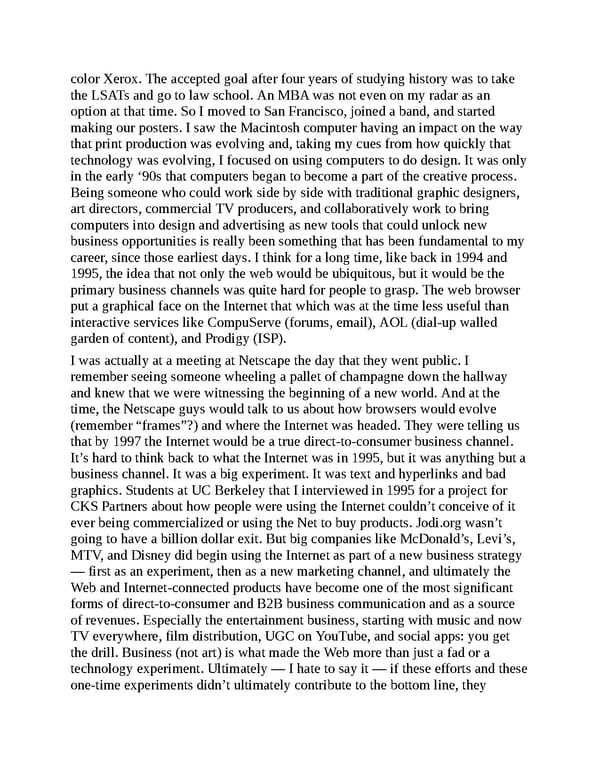color Xerox. The accepted goal after four years of studying history was to take the LSATs and go to law school. An MBA was not even on my radar as an option at that time. So I moved to San Francisco, joined a band, and started making our posters. I saw the Macintosh computer having an impact on the way that print production was evolving and, taking my cues from how quickly that technology was evolving, I focused on using computers to do design. It was only in the early ‘90s that computers began to become a part of the creative process. Being someone who could work side by side with traditional graphic designers, art directors, commercial TV producers, and collaboratively work to bring computers into design and advertising as new tools that could unlock new business opportunities is really been something that has been fundamental to my career, since those earliest days. I think for a long time, like back in 1994 and 1995, the idea that not only the web would be ubiquitous, but it would be the primary business channels was quite hard for people to grasp. The web browser put a graphical face on the Internet that which was at the time less useful than interactive services like CompuServe (forums, email), AOL (dial-up walled garden of content), and Prodigy (ISP). I was actually at a meeting at Netscape the day that they went public. I remember seeing someone wheeling a pallet of champagne down the hallway and knew that we were witnessing the beginning of a new world. And at the time, the Netscape guys would talk to us about how browsers would evolve (remember “frames”?) and where the Internet was headed. They were telling us that by 1997 the Internet would be a true direct-to-consumer business channel. It’s hard to think back to what the Internet was in 1995, but it was anything but a business channel. It was a big experiment. It was text and hyperlinks and bad graphics. Students at UC Berkeley that I interviewed in 1995 for a project for CKS Partners about how people were using the Internet couldn’t conceive of it ever being commercialized or using the Net to buy products. Jodi.org wasn’t going to have a billion dollar exit. But big companies like McDonald’s, Levi’s, MTV, and Disney did begin using the Internet as part of a new business strategy — first as an experiment, then as a new marketing channel, and ultimately the Web and Internet-connected products have become one of the most significant forms of direct-to-consumer and B2B business communication and as a source of revenues. Especially the entertainment business, starting with music and now TV everywhere, film distribution, UGC on YouTube, and social apps: you get the drill. Business (not art) is what made the Web more than just a fad or a technology experiment. Ultimately — I hate to say it — if these efforts and these one-time experiments didn’t ultimately contribute to the bottom line, they
 UX Strategy: How to Devise Innovative Digital Products that People Want Page 313 Page 315
UX Strategy: How to Devise Innovative Digital Products that People Want Page 313 Page 315